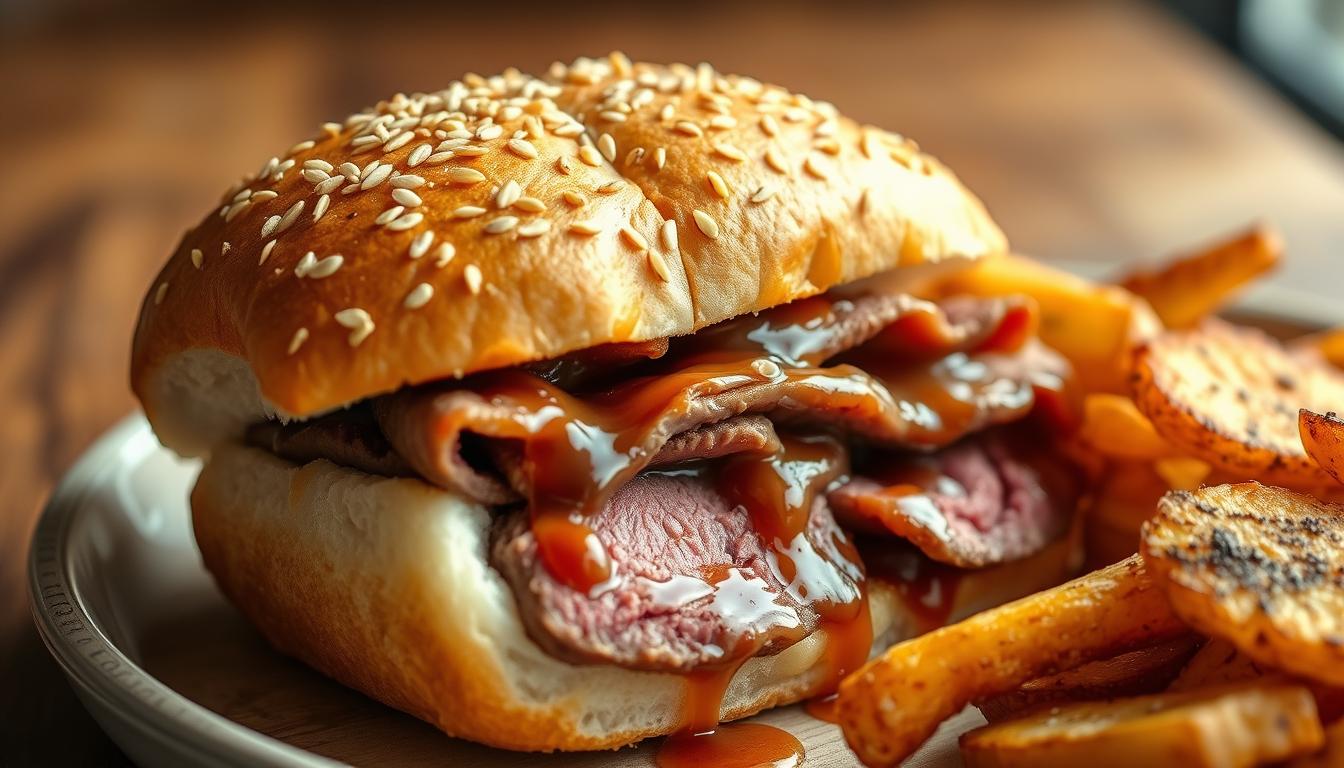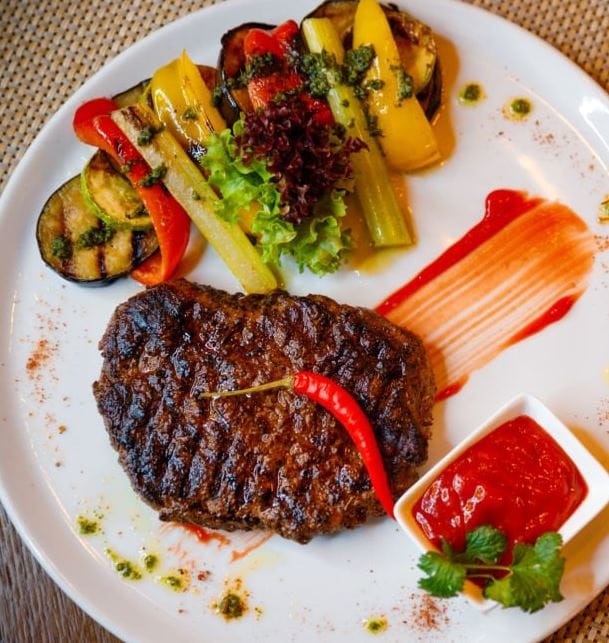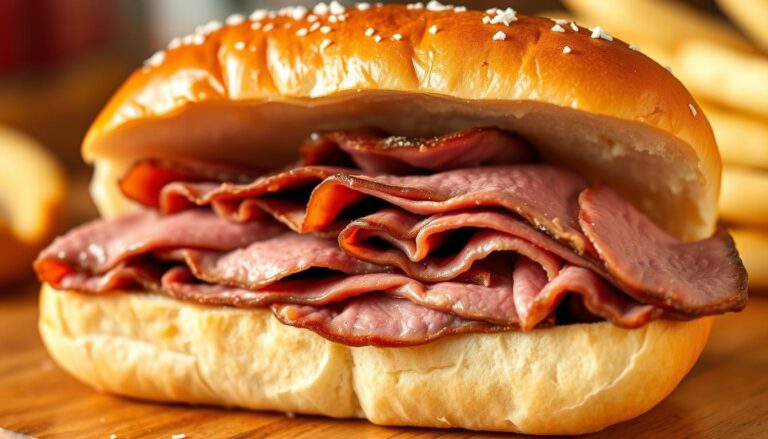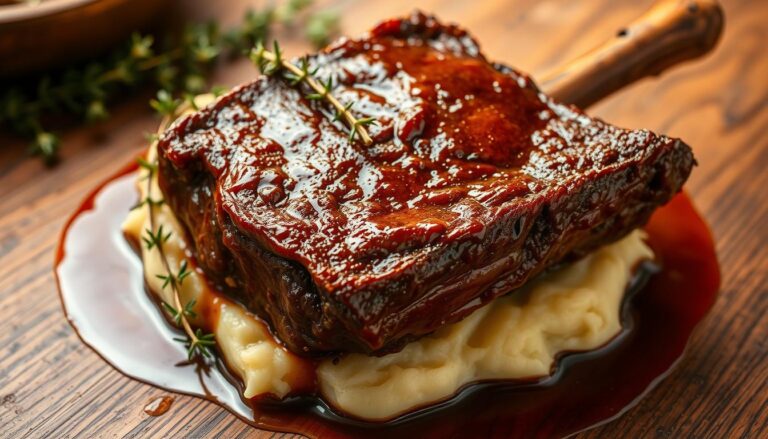Master the Perfect Beef on Weck Recipe
Table of Contents
Master the Perfect Beef on Weck Recipe
If you’re from Buffalo or just love regional American food, you’ve probably tried Beef on Weck. It’s a classic sandwich loved in Western New York for years. It has thinly sliced roast beef on a kummelweck roll, with horseradish and au jus for dipping.
Making the perfect Beef on Weck at home needs careful attention. You must pick the right beef and make real kummelweck rolls. This guide will teach you how to make this iconic sandwich, bringing Buffalo’s taste to your home.
Key Takeaways
- Learn how to select the perfect cut of beef for your Beef on Weck.
- Discover the secrets to crafting authentic kummelweck rolls.
- Understand the importance of horseradish and au jus in the traditional recipe.
- Master the technique of thinly slicing roast beef.
- Explore the history and cultural significance of Beef on Weck in Western New York.
What is Beef on Weck and Its Origin?
German immigrants brought their cooking to Western New York, creating Beef on Weck. This sandwich features tender roast beef on a kummelweck roll. It’s a key part of Buffalo’s food scene. The name “kummelweck” comes from German, meaning caraway seeds and roll.
The story of Beef on Weck is tied to Buffalo, New York’s culture. It started in the 1800s with German immigrants. Taverns served roast beef on a caraway seed roll to boost drink sales.
History of Beef on Weck
The Beef on Weck sandwich comes from German roast beef on a roll tradition. It evolved in Buffalo, becoming a favorite. The kummelweck roll, with caraway seeds and salt, makes it unique.
The Evolution of Beef on Weck happened in Buffalo’s cultural mix of the 19th century. German immigrants adapted their cooking to local tastes.
Cultural Significance in Buffalo, NY
In Buffalo, Beef on Weck is more than a sandwich; it’s a symbol. It’s alongside buffalo wings as a local favorite. It shows Buffalo’s food culture and history.
To understand Beef on Weck’s role in Buffalo, here are some key points:
| Cultural Impact | Historical Significance | Culinary Identity |
|---|---|---|
| Beef on Weck is a source of local pride. | It originated in the 1800s among German immigrants. | Characterized by roast beef on a kummelweck roll. |
| Featured in local events and festivals. | Reflects the cultural adaptation of German cuisine. | Often served with au jus and horseradish. |
| Symbolizes Buffalo’s culinary heritage. | Has remained a staple despite changing culinary trends. | Paired with local beverages like beer. |
Exploring Beef on Weck reveals its rich history and cultural importance. This iconic sandwich shows how food traditions shape local identities.
Essential Ingredients for Beef on Weck
To make a real beef on weck sandwich, you need three key things: the beef, the roll, and the toppings. Each part is important for the sandwich’s taste and feel.
Beef Cut Selection
The top round roast is the classic choice for beef on weck. It’s lean and tastes great when roasted and sliced thinly. Choose a beef cut that’s lean, tender, and full of flavor.
- Top Round Roast: The most authentic choice, with a lean and tender texture.
- Prime Rib: An alternative that brings a richer taste.
Roll Options
A true kummelweck roll is special because of its coarse salt and caraway seeds topping. This gives the sandwich its unique taste. You can make your own kummelweck rolls or buy them from a local bakery that makes traditional Buffalo bread.
- Kummelweck Rolls: The traditional choice, with coarse salt and caraway seeds.
- Homemade Rolls: For those who like to bake their own bread.
Condiments and Add-Ons
The toppings in a beef on weck sandwich are key to its taste. Fresh horseradish is a must, adding a strong flavor that goes well with the beef. Au jus is also important for dipping the sandwich.
- Fresh Horseradish: Adds a pungent flavor that pairs well with the beef.
- Au Jus: Used for dipping, making the sandwich taste even better.
- Optional Add-Ons: Think about adding cheese, onions, or other toppings to make your sandwich your own.
Preparing the Roast Beef
To make a great beef on weck, start with perfect roast beef. The quality of the beef is key, as it’s the main part of the dish.
Choosing the Right Cut
Choosing the right cut of beef is the first step. Top round, bottom round, and eye of round are popular choices. Each offers a different mix of leanness and flavor.
The top round is lean and tender, perfect for a lighter dish. The bottom round is fattier but has more flavor. The eye of round is lean and tender when cooked right.
| Beef Cut | Leanness Level | Flavor Profile |
|---|---|---|
| Top Round | Lean | Mild |
| Bottom Round | Moderate | Rich |
| Eye of Round | Lean | Tender and Mild |
Seasoning Techniques
Seasoning the roast beef is important. Use salt, pepper, and maybe garlic powder or herbs like thyme or rosemary. Keep the seasoning light to let the beef’s flavor stand out.
Tip: Rub the seasonings onto the beef at least an hour before cooking. This lets the flavors soak into the meat.
Cooking Methods for Tenderness
Cooking the roast beef to the right tenderness is key. A crock pot is great for tender meat with little effort. Place the seasoned beef in the crock pot, set it to low, and cook for 8-10 hours.
Roasting in the oven at a low temperature (around 300°F) for a few hours also works. The goal is to cook it low and slow.
If you prefer oven roasting, preheat your oven to 325°F (165°C). Put the roast in a roasting pan and cook until it’s done. Use a meat thermometer to check for medium-rare, aiming for 130°F – 135°F (54°C – 57°C).
Making the Perfect Kummelweck Rolls
To make your beef on weck better, start with homemade Kummelweck rolls. The quality of these rolls is key to a great beef on weck. They have special ingredients and ways of making them.
Ingredients for the Rolls
Kummelweck rolls need bread flour, yeast, salt, sugar, and sometimes milk or butter. The topping is what makes them special: coarse salt and caraway seeds. This mix gives them a unique taste and feel.
- Bread flour: Provides structure and chewiness
- Yeast: Essential for fermentation and rise
- Salt: Enhances flavor and controls yeast growth
- Sugar: Feeds the yeast, promoting fermentation
- Coarse salt and caraway seeds: The distinctive topping
Step-by-Step Dough Preparation
Here’s how to make the dough for Kummelweck rolls:
- Mixing dry ingredients and yeast
- Adding wet ingredients and kneading the dough
- Allowing the dough to rise until it doubles in size
- Shaping the dough into rolls
- Letting the rolls rise again before baking
Kneading is important for the dough’s texture. It involves stretching and folding the dough until it’s smooth and elastic.
| Step | Description | Tips |
|---|---|---|
| 1. Mixing | Combine dry ingredients and yeast. | Ensure yeast is activated. |
| 2. Kneading | Knead until the dough is smooth. | Avoid over-kneading. |
| 3. Rising | Let the dough double in size. | Keep it in a warm place. |
Baking Tips for Fluffy Rolls
To bake Kummelweck rolls right, pay attention to details. An egg wash before baking makes them golden. Sprinkle coarse salt and caraway seeds on top for flavor and texture.
For fluffy rolls, don’t overbake them. They should be around 190°F to 200°F inside. Let them cool on a wire rack to keep their texture.
Mastering Kummelweck rolls will make your beef on weck recipes better. It adds a real Buffalo touch to your cooking.
Assembling Your Beef on Weck
Now that you have your roast beef and Kummelweck rolls ready, it’s time to put them together. This step is key to making a tasty Beef on Weck sandwich. It turns the parts into a complete, delicious dish.
Layering Beef and Toppings
Start by placing a good amount of thinly sliced roast beef on the Kummelweck roll. You’ll want 6-8 ounces of beef per sandwich. Make sure the beef is spread out evenly so every bite is flavorful.
Then, add a dollop of horseradish on top of the beef. You can adjust how much you use based on your taste. Some like a little, others a lot.
How to Properly Slice Beef
Slicing the roast beef thinly against the grain is key for tenderness. You can use a meat slicer or a sharp knife. Aim for slices as thin as paper for easy eating.
To slice against the grain, look at the muscle fibers and cut across them. This makes the beef tender, not chewy.
For a nice look, think about how you present your Beef on Weck. The pink beef and golden roll with salt and caraway seeds look great. If you’re serving many, setting up an assembly line helps keep things efficient.
Traditional vs. Modern Variations
Beef on weck is becoming popular all over the country. New versions of this classic sandwich show off local tastes and preferences. The original recipe, rooted in Buffalo’s food history, has inspired many creative twists.
Common Twists on the Classic Recipe
Today, people are trying different beef cuts, like prime rib instead of roast beef. Some add cheese, which might surprise traditional fans. Others include caramelized onions for a sweet touch. These changes make the dish more exciting for everyone.
- Using prime rib for a richer flavor
- Incorporating cheese for an added layer of taste
- Adding caramelized onions for a sweet and savory mix
Regional Variations Across the U.S.
Beef on weck is now found in many places, with each region adding its own twist. Restaurants across the country mix the classic with local flavors. This creates unique sandwiches that blend different tastes.
| Region | Variation | Description |
|---|---|---|
| California | Avocado Beef on Weck | Adds sliced avocado for a fresh twist |
| Texas | BBQ Beef on Weck | Incorporates BBQ sauce for a tangy flavor |
| New York | Classic with a Horseradish Kick | Emphasizes the traditional horseradish condiment |
The secret to a great variation is keeping the original’s spirit while adding your own twist. Whether you stick to tradition or like to try new things, beef on weck is a blank canvas for your creativity.
Serving Suggestions for Beef on Weck
The true Buffalo dining experience is not complete without knowing how to serve beef on weck. It’s more than just placing it on a plate. It’s about creating a harmonious meal that complements its rich flavors.
What to Pair with Your Sandwich
To elevate your beef on weck experience, consider pairing it with traditional sides that are popular in Buffalo. Some classic options include:
- German potato salad, which adds a tangy and satisfying contrast to the savory beef.
- Macaroni salad, providing a creamy and comforting element to the meal.
- Crispy potato chips, adding a crunchy texture that complements the tender beef.
For a lighter take, you can also serve your beef on weck with vegetable sides such as:
- Dill pickle spears, which cut through the richness with their sourness.
- A simple vinegar-based coleslaw, adding a refreshing crunch.
Recommended Side Dishes
When planning a meal around your beef on weck, consider the overall balance of flavors and textures. For a more formal gathering, you might want to include a variety of sides to cater to different tastes. Some recommendations include:
- Roasted vegetables, such as asparagus or Brussels sprouts, for a healthier and flavorful option.
- A simple green salad with a light vinaigrette, providing a palate cleanser between bites of the rich sandwich.
- Baked beans or braised greens for a heartier, comforting side dish.
Presentation is also key. Consider plating your beef on weck on a wooden board or a rustic plate. Garnish with fresh herbs or a side of au jus for dipping. This not only enhances the visual appeal but also adds to the overall dining experience.
For larger gatherings or Buffalo-themed parties, you can scale your beef on weck recipe. Keep in mind the serving temperatures to ensure all elements of the meal are at their best. A well-planned beef on weck meal is sure to impress your guests and transport them to the heart of Buffalo, NY.
Storing Leftovers Properly
Storing leftovers right is key to keeping your Beef on Weck tasty.
To keep roast beef fresh, put it in an airtight container in the fridge. Slice the beef just before serving for the best taste. If it’s already sliced, wrap it tightly to stop it from drying out. Food safety experts say “Leftover roast beef can be safely stored in the refrigerator for 3 to 4 days.”
Best Practices for Refrigeration
For Kummelweck rolls, keep them in a cool, dry spot or freeze them. Avoid storing rolls in airtight containers to prevent them from getting soggy.

Reheating Techniques
Reheat your Beef on Weck in a crock pot to keep the roast beef moist. For the rolls, a quick oven toast can make them fresh again.
Think about turning leftover roast beef into a hash or stew for a new meal.
Beef on Weck and Beverage Pairings
Enjoying a beef on weck is even better with the right drink. The secret is to match the flavors of the roast beef and the kummelweck roll.
In Buffalo, NY, locals often choose local beers to go with their beef on weck. Here are a few favorites:
- Flying Bison Brewing Company’s Rusty Chain: A local favorite that pairs well with the richness of the beef.
- Labatt Blue: A crisp lager with ties to the Buffalo region, ideal for cutting through the sandwich’s richness.
Beer Recommendations
Beer lovers have many options to pair with beef on weck. A crisp lager can cut through the richness. A hoppy IPA can handle the horseradish’s kick.
Other beer styles to try:
- Pale Ale: Offers a balanced flavor that complements the beef without overpowering it.
- Amber Ale: Provides a malty sweetness that pairs well with the savory beef.
Non-Alcoholic Options
For those who don’t drink alcohol, there are great choices too. Here are some:
- Craft Root Beer: Adds a sweet and creamy contrast to the savory sandwich.
- Unsweetened Iced Tea with Lemon: Provides a refreshing contrast to the richness of the beef.
- Loganberry Drink: A Western New York specialty that offers a unique flavor profile.
Think about the season and setting when picking a drink. For a summer picnic, try iced tea or loganberry. For a cozy winter meal, a warm, malty beer is perfect.
Health Considerations with Beef on Weck
It’s important to know the nutritional content of beef on weck for a healthy diet. Enjoying this sandwich while being aware of its health effects can guide your choices.
Nutritional Information
A traditional beef on weck sandwich has a lot of calories. This comes mainly from the roast beef and the kummelweck roll. The roast beef is rich in protein but can also have a lot of fat, depending on the cut. The kummelweck roll adds carbs, and the horseradish and au jus increase sodium.
Here are the approximate nutritional values per serving:
- Calories: 600-800
- Protein: 40-50 grams
- Fat: 20-30 grams
- Sodium: 1000-1500 mg
- Carbohydrates: 60-70 grams
Making Healthier Choices
To make a healthier beef on weck, choose leaner cuts of beef and watch your portion sizes. You can also use whole wheat or smaller kummelweck rolls. For special diets, try lower-carb or gluten-free rolls.
By paying attention to these details, you can enjoy beef on weck without compromising your diet. A few tweaks can greatly improve the nutritional profile of this classic dish.
Hosting a Beef on Weck Event
Want to wow your guests with a special meal? Try hosting a Beef on Weck-themed party. This famous sandwich from Buffalo, New York, will delight your friends and family.
Planning a Buffalo-Themed Party
To bring Buffalo to your party, decorate with local touches. Use Buffalo’s colors, show off sports teams, and highlight Buffalo foods like wings and sponge candy.
Buffalo-Themed Decor Ideas:
- Choose Buffalo’s colors: navy blue and red.
- Display Buffalo landmarks like the Richardson Olmsted Campus.
- Have a “Taste of Buffalo” station with local treats.
Tips for Serving a Crowd
For a big group, plan ahead. Use a crock pot to keep the roast beef warm and tender. You can make more beef on weck crock pot for everyone.
Here’s a simple guide to help you plan:
| Number of Guests | Roast Beef Quantity | Kummelweck Rolls |
|---|---|---|
| 10-15 | 2-3 pounds | 15-20 rolls |
| 20-25 | 4-5 pounds | 25-30 rolls |
| 30+ | 6+ pounds | 30+ rolls |
Offer different sides and condiments, like au jus and horseradish. This lets guests make their own perfect sandwich. Make sure to have options for those who don’t eat beef.
With these tips, your Beef on Weck event will be a hit. It’s perfect for any party, big or small. Beef on Weck will be the main attraction.
Crafting Homemade Au Jus
The secret to a great beef on weck is its au jus. This flavorful sauce makes the dish unforgettable. Au jus, or “in juice” in French, is the meat’s cooking juices.
For a beef on weck recipe, a rich au jus is key. It adds moisture and flavor to the roast beef.
Ingredients for Au Jus
To make a tasty au jus, you need a few ingredients. Start with the drippings from your roast beef. These drippings have the meat’s concentrated flavors.
You’ll also need beef stock or broth. You can buy it or make it yourself. Add red wine (optional), beef bouillon, and a pinch of thyme and bay leaves for extra flavor.
| Ingredient | Quantity | Purpose |
|---|---|---|
| Roast beef drippings | 2-3 tablespoons | Base flavor |
| Beef stock | 2 cups | Enhances beef flavor |
| Red wine (optional) | 1/2 cup | Adds depth |
| Beef bouillon | 1 teaspoon | Intensifies flavor |
Cooking Tips for the Perfect Dip
To get the perfect au jus, start by deglazing the roasting pan. Use red wine or beef stock to scrape up browned bits. Then, mix the pan drippings, beef stock, and seasonings in a saucepan.
Simmer the mixture until it thickens a bit. This will make it the right consistency.
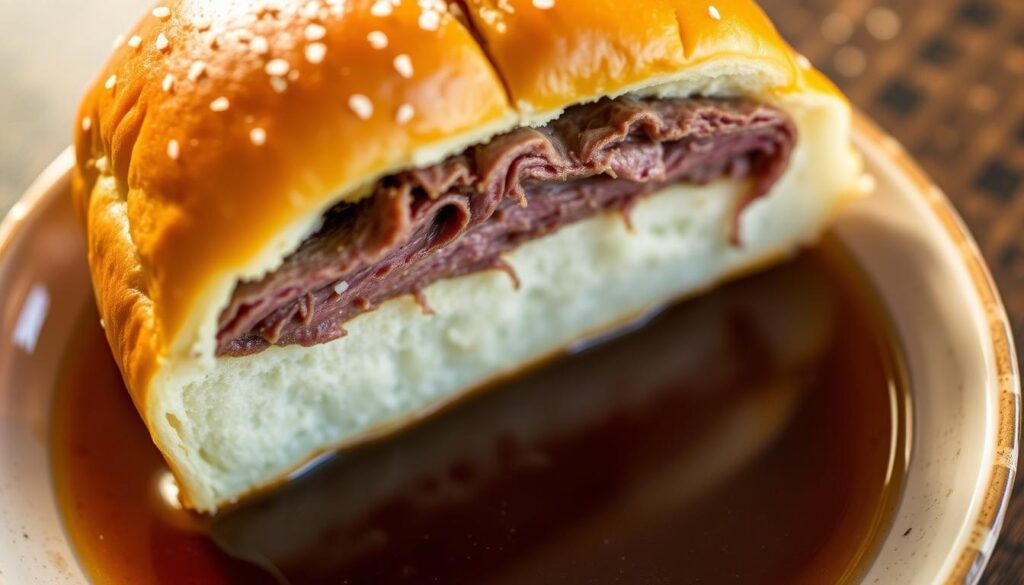
When serving, keep the au jus warm but not boiling. Aim for a temperature between 145°F and 155°F. Use a thermally insulated container or a chafing dish with a heat source to keep it warm.
Understanding the Role of Horseradish
Horseradish adds a unique flavor to the beef on weck. It balances the savory roast beef and the caraway seeds in the roll. This pungent condiment is key, making the dish a classic beef on weck sandwich recipe.
Benefits of Adding Horseradish
Adding horseradish to your beef on a weck recipe has many benefits. It cuts through the richness of the roast beef, creating a balanced taste. The compounds in horseradish, like allyl isothiocyanate, add a sinus-clearing heat that complements the dish.
Horseradish also adds complexity to the taste, making the dish more enjoyable.
Available Types of Horseradish
You can choose from different types of horseradish for your beef on weck. Fresh horseradish root has the strongest flavor. Prepared horseradish in jars is convenient, with varying heat and vinegar levels.
When using fresh horseradish, handle it carefully to avoid irritation. Grate or process it just before serving to get the most flavor and aroma.
You can spread horseradish on the roll or serve it on the side. The amount used depends on your heat preference, making it adaptable for everyone.
Reader Reviews: What People Say
Reader reviews give us a peek into the success and challenges of making beef on weck. Home cooks from all over have shared their stories. They offer valuable insights into this beloved dish.
Feedback from Home Cooks
Many home cooks love the beef on weck recipe for its ease and taste. One reader said, “
I’ve never been to Buffalo, but this recipe made me feel like I was there. The horseradish sauce was a game-changer!
“
Some have tried their own twists, like using different beef cuts or unique toppings. For example, a California resident mentioned, “
I used a slow cooker for the roast beef, and it turned out tender and delicious. I also added some caramelized onions on top for extra flavor.
Popularity Within the Buffalo Community
In Buffalo, beef on weck is a big part of local food. Both long-time residents and newcomers love it for its taste and memories. A Buffalo native said, “
Beef on weck is more than just a sandwich; it’s a taste of home. Whenever I’m back in Buffalo, I make it a point to visit Schmitt’s of Buffalo for an authentic experience.
“
The dish is also popular on social media. Food lovers share their versions and stories. This has made beef on weck known to more people. Many love its unique taste.
Troubleshooting Common Issues
Making the perfect beef on weck is achievable with a little troubleshooting know-how. Even experienced cooks can encounter issues when preparing this classic dish. In this section, we’ll address common problems and provide practical solutions to ensure your beef on weck turns out delicious every time.
Reviving a Dry Roast
A dry roast can be a disappointment, but there are ways to rescue it. One method is to slice the roast thinly and serve it with a generous amount of au jus to add moisture. You can also try using a beef on weck crock pot method for your next attempt, as slow cooking can help guarantee tenderness.
- Slice the roast against the grain to improve texture.
- Serve with additional au jus or horseradish sauce to add moisture and flavor.
- Consider repurposing the dry roast into another dish, like beef sandwiches or salads.
Preventing Soggy Rolls
Soggy rolls can ruin an excellent beef on weck. To avoid this, toast your kummelweck rolls before assembling the sandwich. You can also apply a layer of horseradish sauce or au jus to the roll, but be cautious not to overdo it, as this can lead to sogginess.
- Toast the rolls lightly before adding the beef.
- Apply horseradish sauce or au jus sparingly.
- Assemble the sandwich just before serving to minimize the time the roll spends in contact with the beef and juices.
By following these troubleshooting tips, you can overcome common issues and enjoy a delicious beef on kimmelweck recipe. Whether you’re a seasoned cook or just starting out, these solutions will help you achieve a mouth-watering beef on weck that impresses family and friends alike.
Conclusion: Perfecting Your Beef on Weck
Mastering the beef on weck sandwich recipe takes practice and attention to detail. But, the end result is a delicious taste of Buffalo, NY. You now know the key parts of this regional specialty.
These include the tender roast beef, the crusty kummelweck rolls, and the tangy horseradish.
Key Takeaways
To perfect your beef on weck, choose the right cut of beef. Prepare the kummelweck rolls with care. And balance the flavors with horseradish and au jus.
These elements come together to make a truly exceptional sandwich.
Experimenting with Variations
Once you’re confident in making a traditional beef on weck, try your own recipes. Experiment with different seasonings, toppings, or condiments. This way, you can create a signature version that shows your personal taste.
The rich culinary tradition behind this sandwich encourages creativity. It respects its heritage at the same time.
With each attempt, evaluate your results and make adjustments. You’re not just making a sandwich; you’re connecting with a cultural tradition. It brings people together. Enjoy the process, and happy cooking!
FAQ
What is the best cut of beef for a Beef on Weck recipe?
How do I make kummelweck rolls from scratch?
Can I use a crock pot for the roast beef in Beef on Weck?
What is au jus, and how is it made?
How do I properly store leftovers from a Beef on Weck recipe?
What beverages pair well with Beef on Weck?
How can I make a healthier version of Beef on Weck?
What are some common issues with making Beef on Weck, and how can I fix them?
Can I make Beef on Weck ahead of time for a party?
What is the role of horseradish in Beef on Weck?
For more cooking tips, stay connected with us. We also recommend the cookbook Skinnytaste Simple: Easy, Healthy Recipes with 7 Ingredients or Fewer
For more Recipes about Beef?
Did You try our recipe ?
There are no reviews yet. Be the first one to write one.
